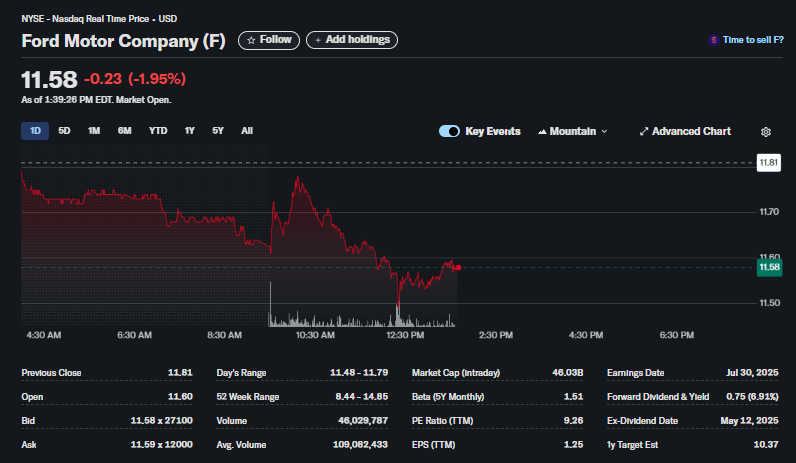Ford (F) Stock Slides Under $11.60 as Investors Weigh High Yield Against Headwinds

As of 1:39 PM EDT, the legacy automaker’s stock was priced at 0.23, or 1.95%, for the session. The stock gapped down at the market open and has remained under pressure throughout the day, hitting a low of $11.48 before attempting to stabilize in the early afternoon.

The trading action suggests a negative sentiment is currently surrounding the automotive giant, despite some compelling valuation and income metrics. Volume is active, with over 46 million shares traded so far.
Key Financial Metrics from the Chart:
-
Previous Close: $11.81
-
Day’s Range: $11.48 – $11.79
-
P/E Ratio (TTM): 9.26
-
EPS (TTM): 1.25
-
Forward Dividend & Yield: 0.75 (6.91%)
-
1y Target Est: $10.37
Ford’s key metrics present a mixed picture. The company is profitable (positive EPS) and trades at a low price-to-earnings (P/E) ratio, which typically attracts value investors. Its dividend yield is exceptionally high at nearly 7%. However, the 1-year analyst price target is notably below the current trading price.
Should You Buy or Sell F Stock Today?
Ford’s current situation presents a classic dilemma between value/income investing and growth/momentum. This analysis is for informational purposes only and should not be considered financial advice.
The Bearish Case (Reasons for Caution):
The most immediate bearish signal is the stock’s negative price action and its clear intraday downtrend. The most significant red flag for potential investors is the 1-year analyst target estimate of $10.37, which suggests Wall Street analysts, on average, see the stock declining from its current level over the next year. This could reflect concerns about competition in the EV space, economic slowdowns affecting car sales, or execution risks.
The Bullish Case (The Value and Income Play):
For value and income-focused investors, Ford holds significant appeal. The company is profitable (EPS of $1.25) and its P/E ratio of 9.26 is low, suggesting the stock may be undervalued relative to its earnings. The primary attraction is the robust forward dividend yield of 6.91%, which provides a substantial income stream for shareholders. Investors buying at these levels are collecting a high yield while waiting for a potential turnaround in sentiment.
Our Opinion
Ford Motor Company (F) is currently a tale of two stocks. For traders focused on technicals and short-term momentum, the current trend is negative. However, for long-term investors focused on value and income, Ford presents a compelling case with its low P/E ratio and one of the higher dividend yields among large-cap stocks.
The key question for investors is whether the attractive dividend is sustainable and if it’s enough to compensate for the stock’s current price weakness and negative analyst outlook. This stock appears best suited for patient, income-oriented investors who are comfortable with the cyclical nature of the automotive industry.
Frequently Asked Questions (FAQ) about F Stock
1. What is the stock ticker for Ford Motor Company?
The company’s stock trades on the New York Stock Exchange (NYSE) under the ticker symbol F.
2. Does Ford stock pay a dividend?
Yes, Ford pays a dividend. Based on the chart, its forward dividend yield is a very high 6.91%, which is a key reason many investors own the stock.
3. Is Ford a profitable company?
Yes. According to the data provided, Ford has a positive Earnings Per Share (EPS) of $1.25 over the trailing twelve months (TTM), indicating profitability.
4. What is the analyst price target for Ford stock?
The 1-year analyst target estimate shown on the chart is $10.37. This is the average price target from analysts covering the stock.
5. What is Ford’s P/E ratio?
Ford’s trailing twelve-month (TTM) P/E ratio is 9.26. A P/E ratio under 10 is generally considered low and can indicate that a stock is undervalued.
6. Why is Ford stock down today?
While there could be a specific catalyst not shown on the chart, the decline is part of a clear intraday downtrend. This could be driven by broader market weakness, sector-specific concerns, or investors reacting to the negative analyst price targets despite the high dividend.

